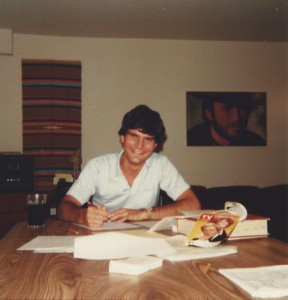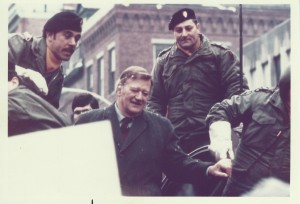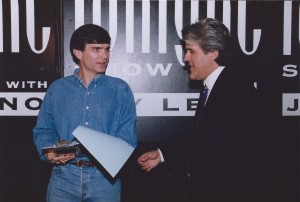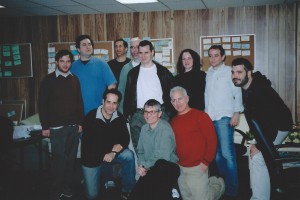About Joe
 I graduated from Harvard with a Bachelor of Science degree in Engineering and Applied Physics. I also have a Harvard MBA. So how did I end up writing comedy for television? I’ve always enjoyed making fun of things and putting words together. So back in college I joined the Harvard Lampoon. A highlight: with most of the Harvard community against the Vietnam War, I arranged for the Lampoon to parade hawkish screen legend John Wayne into Harvard Square on an armored personnel carrier.
I graduated from Harvard with a Bachelor of Science degree in Engineering and Applied Physics. I also have a Harvard MBA. So how did I end up writing comedy for television? I’ve always enjoyed making fun of things and putting words together. So back in college I joined the Harvard Lampoon. A highlight: with most of the Harvard community against the Vietnam War, I arranged for the Lampoon to parade hawkish screen legend John Wayne into Harvard Square on an armored personnel carrier.
The stunt was reported by the media all over the world and gave me a tantalizing taste of working in show business. But in those pre-Saturday-Night-Live days it took me a while to realize that a career in comedy might even be possible. After getting my MBA I worked for General Foods, marketing Cycle Dog Food. The most fun I had there was meeting my future wife at a dog Frisbee-catching contest in Manhattan’s Battery Park. (It was a classic meet-cute: she worked on Cycle Canned and I worked on Cycle Dry.) Meanwhile I took a small step toward a career in TV by writing a spec episode of the light detective show Hart to Hart.

Working on my “Hart to Hart” spec script in the summer of 1980 at my kitchen table in White Plains, New York
I took another step towards TV writing by getting a job at Columbia Pictures, but as a financial analyst I was in the right circus, wrong tent. (Trivia: I was a member of the small group that created Tri-Star Pictures.) Then a friend from the Lampoon, Jim Downey, called. He generously invited me to submit a writing sample to Late Night with David Letterman, where he was head writer. The show had been on the air for less than two years but Jim and several other writers were planning to leave. My understanding wife of four months supported my attempt to make the drastic career change. We agreed that if the TV comedy thing didn’t work out, I could put on a suit again, plead temporary insanity, and slink quietly back into the business world. I got hired onto Late Night and about a year later we writers won our first Emmy. Still, the real prize to me was having a steady job that I loved.
Three more Emmys followed but I eventually developed a strong urge to write longer-form comedy. I moved my family to Los Angeles. There I landed a series of staff positions, writing for the sketch show In Living Color and the situation comedies Doctor Doctor, Hangin’ with Mr. Cooper, Charlie Hoover, and Scorch. (You all remember that show about the talking dragon, right?) Unsatisfied, I returned to the arms of the woman who brought me to the dance, comedy/talk shows, and became co-head writer of The Chevy Chase Show. The show was cancelled in less time than it took to type this sentence. But fortunately I was able to jump to a co-head writer slot on The Tonight Show with Jay Leno. (For a behind-the-scenes look at my adventures there, read my book Comedy Writing for Late-Night TV.) While I was on staff, the show won an Emmy for Outstanding Variety, Music or Comedy Series.
For family reasons we Toplyns relocated back to New York, where I joined Late Show with David Letterman as its head writer. Years later I migrated into daytime as head writer of The Caroline Rhea Show and into cable as a writer/producer on the comedic detective show Monk. (At Monk I would have pitched the murder idea I used in my Hart to Hart spec script but the show had already done a parachuting episode.)
Since then I wrote that book I mentioned and founded a startup, Twenty Lane Media, LLC. Our first tech product exploits my experience in comedy and also engineering. It’s Witscript (U.S. Patent Nos. 10,642,939; 10,878,817; and 11,080,485), the first artificial intelligence to ad-lib real jokes.
I have two wonderful sons and live in Westchester County, New York, with my amazing wife.




I love all of your Monk episodes, especially Voodoo Curse and Missing Granny. I’m curious–when coming up with mysteries for Monk, where did you start? Did you begin with a crime and then try to cover it up, like the imaginary culprit would, or did you start with something inexplicable, and then work your way backward to explain it, just like Monk? And how on earth did you come up with so many inexplicable scenarios?? I’m very impressed!
Hi, Christine! Thanks for your kind words about my episodes.
I, like other “Monk” writers, gravitated toward mysteries based on perfect murders, for example, locked-room murders. So I would start by coming up with an inexplicable scenario, as you guessed, like a deadly voodoo curse that appears to be real. Then I and the other writers would solve the puzzle of how that inexplicable scenario could actually have been a clever murder.
To come up with those inexplicable scenarios I would often brainstorm ways that people could die. There are lots of ways, as you can imagine, which meant lots of possible murder puzzles.
I just wanted to say that I’m a huge fan of yours. Your book is wonderfully incisive, and I also happen to be a particular fan of yours through your work on MONK. You co-wrote my favorite episode “Mr. Monk Goes to the Dentist,” which I’ve always thought was impeccably constructed. I think that the first story Alfred Hitchcock ever wrote had a similar premise, namely in its description of a woman who is unsure whether or not she’s hallucinating while under anesthesia at the dentist’s. It also has a vague resemblance to Agatha Christie’s “One, Two, Buckle My Shoe” in which Hercule Poirot solves a murder that takes place around the same time as his own dentist visit. I was curious if either of these stories were muses for you and the Monk writing team on this episode? It seems as if dentists and dentists’ offices have been inspiring murder mysteries for the better part of a century, now!
I also just wanted to express my appreciation for your work. I find your personal bio to be incredibly inspiring, as I, too, find myself in the “right circus, wrong tent” (love this idiom, by the way)- I work on the business side of the studios, but would definitely like to nurture my interests in writing and move in a more creative direction in the future.
I wish you the best in the upcoming New Year, and thanks for all of the laughs, entertainment, and wisdom you’ve provided in your TV writing, and your book.
Thanks for your kind message. I’m very glad that something I did or wrote may help you on your own path to writing fun.
You really know mysteries. I don’t remember discussing either the Agatha Christie or Hitchcock stories in the writers’ room, but it’s possible that one of the other writers had heard of them.
Here’s an anecdote about the “Monk” dentist episode. When the writers were first kicking the basic idea around, one of us raised the question of whether dentists’ patients actually do talk under anesthesia.
I remembered that a dentist had an office right downstairs from the “Monk” offices and suggested that our writer’s assistant go down and ask. Our assistant reported back that the dentist said anesthetized patients talk “all the time.” So we developed our story, reassured that it was plausible.
Hi Joe,
Love the book, it’s an inspiring resource for my writing. One question on formatting if you don’t mind (I’ve seen different answers about this but figured I’d ask the expert). I’ve written scripts using the standard format, which in my experience times-out correctly when shooting film to one page per minute.
Sitcom/TV comedy formats seem unnecessarily double spaced in the dialog and text formatting, particularly the SNL format. I get that it works for them, but for general comedy packets, is it ok to use the standard script format for sketches, ad parodies etc.? Thanks.
Hi, Frank. I’m very glad my book has been helpful. Thanks for saying so.
Yes, in a generic writing packet for a comedy/talk show or a sketch show it’s perfectly okay to use feature film formatting for sketches, i.e. single space the dialogue and the action descriptions. Double spacing would fatten up your packet unnecessarily and may scare off a casual reader.
Joe,
I just stumbled onto your site. I am a huge MONK fan and see your name in the credits as I watch, and rewatch, my beloved MONK DVD’s. The writing, acting, editing was so good on that show it makes me want to spit on the floor or something. There will never be another MONK TV show. It can never get that good again. I’ve only loved a few shows in my lifetime enough to swear by them or enough to say that they literally changed my life and MONK is one of them if not the only one. I seriously adore that show.
I was fascinated by your profile here. Just now looking around and wanted to say hello. So, it all started at Harvard on the Lampoon? Interesting. Anyway, God bless you and yours. I might look you up on Facebook so ….. look out :-).
Hi, Cecil,
Thanks very much for stopping by my website and for your kind words about “Monk.” I’m really glad you like the show. It was so much fun to write. And the cast and crew were so talented that they made the writers look good.
Writing murder mysteries and writing jokes are more similar than one might think. They both require creating puzzles. In the case of a murder mystery, the puzzle involves carefully planting clues that lead to a surprising but logical murderer. In the case of a joke, the puzzle involves carefully arranging words that lead to a surprising but logical punch line.
Not that you asked. I just thought you might be interested.
Have fun!
Mr. Toplyn,
Thank you for the reply and the tip. Clearly, there is some structure to joke and skit writing. I can’t say I understand it just yet and I do plan to buy your book later this year (I have a few projects keeping me busy ahead of it). Currently, I makes attempts at humor in spec screenplays. I am a writer too. My first four completed scripts are action/adventure genre. Then I realized it is smart to write some low or lower budget stuff so I popped out a comedy. I’m outlining another low budget feature length comedy now.
I aim for comedy at this point by gut instinct, however, a book such as yours, one that could teach me the keys to structuring a good joke or skit, surely could help. In fact, just now I thought of a good skit that might work on SNL or a show like that and I might write it up and send it to you, if you’d like. Nothing expected in return. Just bouncing ideas around. I may email you again about that one of these days. I hate to be so evasive, but as I said I am in hot pursuit of a new project and until I finish the outline, I am afraid the thing will never see the light of day. Thanks for having a site like this and replying to newbies like me :-).
If you’re outlining a movie now, I recommend you read John Truby’s book “The Anatomy of Story.” It might be the best book I’ve read on how to write a feature.
Jokes, sketches, sitcoms, one-hour dramas, features…they all tell stories. And at least 75% of what makes them successful is having a solid story structure.
Hello Joe,
My name is Mark and I just stumbled across your site through a google search. I applaud you and your successes!!
My question for you is: Is there conflicting points on plotting in Christopher Voglers “The Writer’s Journey” and John Trubys “The Anatomy of Story”?
Hi, Mark,
No, I don’t think Chris Vogler and John Truby offer any conflicting advice about how to plot a story. I think their story templates reflect the same basic structure. Each template just has some details that the other one lacks. The same applies to Blake Snyder’s “Save the Cat” story template.
I’m a big fan of outlining, and of those three authors, and I find their story templates really useful.
In fact, when I write a screenplay outline, I’ll make sure that it includes the beats of all three templates. That way, if a potential buyer looks for the beats of his or her favorite story guru in my script, those beats will be there.
Have you found any conflicting advice from Vogler and Truby?
Best,
Joe
Thank you for the response, Joe.
I’m new to writing and when I saw what each had to offer, I thought I’d have to make a choice between the two as far as how to structure a plot. Then I saw your website, read your credentials, asked my question and am very grateful for your reply.
Have a good day!
Mark
You’re welcome, Mark.
I think you’re smart to be paying so much attention to story structure. You’ll save yourself a ton of time by minimizing rewriting.
Plus your final draft will be compelling because it will be built on a strong story foundation.
Have fun!
Hi Joe… I’ve enjoyed your book so far. Thanks for writing such a thorough book on comedy writing. I’ve been worried about how I submit my writing because there have been so many stories of ideas being stolen. Even putting your work online or on Twitter seems foolish. Am I being overly cautious? Thanks again!
Hi, Andy. Thanks for your kind words about my book! Once I got going on it, I tried to make it as comprehensive as I could.
Yes, comedy material does get stolen from time to time. So if your material is potentially really valuable, like a screenplay, I’d register it with the Writers Guild or Copyright Office before giving it to anybody other than trusted friends to read. Even then, I’d only give screenplays, TV pilots, and other long-form material to people who seem legitimate. I wouldn’t post it online unless you use a service like Inktip that does some screening of readers.
I think shorter comedy material like jokes and sketches (the material covered in my book) is okay to post online. The benefit of publicizing your skills that way outweighs the potential cost to you of having the material stolen. If shorter material is stolen, you can easily replace it with new, fresh material if you’re a pro comedy writer, which is how you want to portray yourself.
And if your short-form material is topical, like monologue jokes for a late-night show, it’s less likely to get ripped off because its shelf-life is so limited. Lots of people in the comedy community are on Twitter, so posting topical jokes there can be a good way to get their attention.
I had never heard of Inktip, so I’ll check that out. Really appreciate the advice and the book. Have a happy and healthy new year!
Happy 2016 to you, too, Andy!
Pingback: Interview: Joe Toplyn – From getting far in comedy writing to going too far with a joke – Punchline
Your book is amazing! Thank you so much for writing it. It is a field guide for all of us that hope to be a part of a comedy show in some capacity.
Kudos!
Thanks a lot for buying my book and saying such nice things about it. I tried to make it really practical and useful, even for people who just want to write funnier material in their daily lives.
Just starting your look now and really enjoying it a lot. Great job – thanks for writing it. A couple of quick formatting questions for the submission packet: Assuming that you’re not specifically told by the submission guidelines/person, should everything be double-spaced lines? And Is it okay to print on both sides of the page?
Thanks again!
Mike McNulty
Hi, Mike! Thanks for reading my book. I’m really glad you’re finding it helpful.
I wouldn’t double space the material in your submission packet. Double spacing would just make the packet seem longer and less inviting to read.
I also wouldn’t print on both sides of the paper. Actual scripts that shows use are only printed on one side of the paper, so if anybody ever photocopies your submission there’s a chance that half your material will accidentally not get copied.
Best of luck, and have fun!
Thanks again, Joe. Not only is your book really helpful and informative, but it’s very funny, too!
Thanks for saying so, Mike!